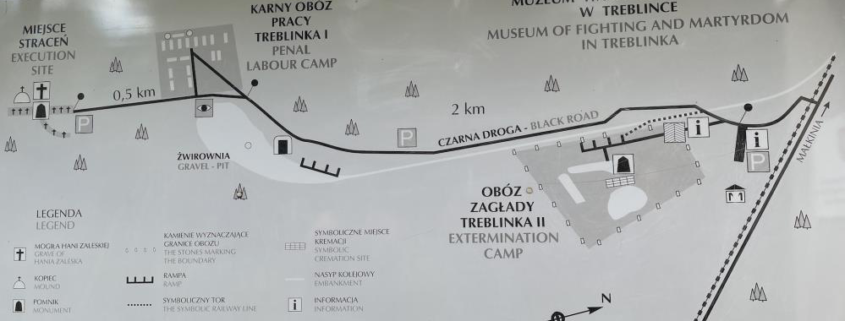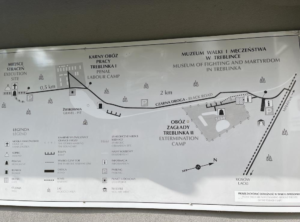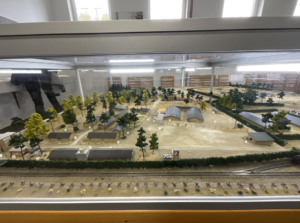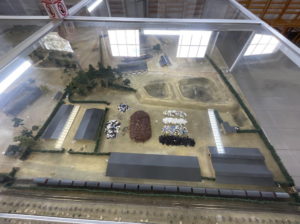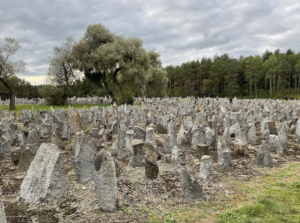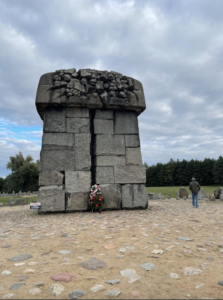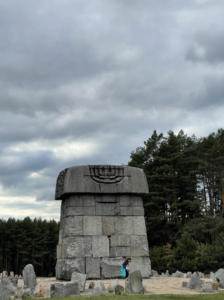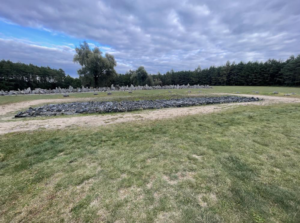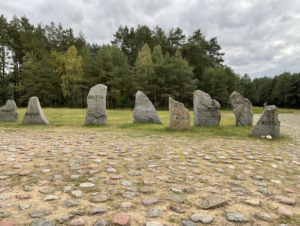Treblinka: The Invisible Extermination Camp
By Capriana Cormier
When people learn about the Holocaust, they learn about Auschwitz I and Auschwitz II – Birkenau. This history dominates what we know about the Holocaust and leaves other concentration and extermination camps invisible to the rest of the world. After our two-week traveling seminar, I had a lot to think about. I had seen and discovered so much in such little time. Some emotions I have had during this travel seminar have been easier to explain than others have been, some I have come to accept, and others are still lingering around trying to find a place. On the 28th of September 2021, I visited Treblinka, an extermination camp. Treblinka was one of the most impactful places that we had visited. It was only then, when I was at Treblinka, did I realize that this place needs to be spoken and taught about the same way Auschwitz is.
Treblinka was an extermination camp active from 23rd of July 1942 until October of 1943, Treblinka was built as a part of Operation Reinhard. Operation Reinhard was a secretive plan made by the Germans to exterminate all the Polish Jews in the General Government in occupied Poland. Operation Reinhard was responsible for the murder of about 1.7 million Jews, mostly Polish. Approximately 870,000 Jews, were murdered at Treblinka. Although there is not a confirmed number due to lack of documentation of who was at the camp. About 6,000 – 7,000 Jews were murdered a day at Treblinka.
During our visit, our tour guide, Marta, provided many facts about Treblinka and asked many questions that would require deep self-reflection. One question lingered and I am still unsure if I have my answer. The question Marta asked us at the beginning of the tour was “Why are you here?” I did not have the answer when she first asked, and I did not have the answer by the end of our tour. If, or when, anyone visits any death sites this should be a very prominent question that one aims to answer before, during, or after visiting a mass murder camp such as Treblinka.
The other question Marta asked, and one that I would like to address, is “Did you learn about Treblinka while learning about World War II and the Holocaust, or did you mainly just hear about Auschwitz I and Auschwitz II – Birkenau? If you did not learn about Treblinka, why do you think that was?” My answer to this question was no, I had not learned about Treblinka in any of my history courses, I had only known about Treblinka and other extermination camps because of my own research for my interest in what happened during the Holocaust. Marta expected these answers, and there we had learned that out of 870,000 Jews that were murdered only 200 were able to escape the camp, 35 of the 200 survived the war, and few spoke out about their experiences and what they saw happen at Treblinka.
We hear about Auschwitz because of the still standing camps, and the number of survivors. However, it is just as important that we learn about what happened at Treblinka the same as we learn about Auschwitz. During the tour we learned that Jews were led down a road called the “die Himmelstaße” which meant “the road to heaven.” On the walk down the road there were signs indicating that victims were heading towards a bathhouse; they could also see buildings with religious symbols on them. Walking down this road, one would feel safe. The Nazis designed it for this reason; they did not want to make it obvious that the route in fact led not a bathhouse but to the gas chambers.
There is nothing left of Treblinka. The entire camp was torn down when the Nazis heard the Russians were heading their way. When I was at Treblinka an overwhelming amount of sadness came over me. I was more affected by this camp because nothing was there. No trace other than a small building with some remains, a 3D model of the camp, and a memorial site to commemorate the lives lost. I felt very overwhelmed when I first walked on the camp site. There was no camp to “walk through,” it was a vastly different experience than I had at Auschwitz. The walk down to the memorial was emotional. I put myself in the shoes of a prisoner, standing in front of the train tracks, walking down the same path the prisoners walked to their deaths, I could not stop crying. This is when it truly became so apparent to me that people need to know about this camp, people need to learn about the tragic history of this camp, people need to see the Holocaust at every camp, every life taken, not just the lives at Auschwitz.
It is important be educated about other camps like Treblinka. Auschwitz dominates conversation and learning topics, but there is so much more than Auschwitz. It is important to make sure that we are taught all aspects of this tragic history. It is important to remember the lives lost at other camps that were smaller than Auschwitz. Auschwitz I and Auschwitz II – Birkenau together claim 1.1 million lives, the numbers are not so different. 870,000 lives were taken at the Treblinka extermination camp. Almost the same number of lives, majority of them Jews, were murdered at both camps yet Treblinka lies in the shadows.
Personally, this was a tough experience, and I was not ready, nor am I sure I ever would have been ready to visit any extermination and/or concentration camp. I believe because there was nothing, or barely anything, left behind this was one of the most impactful experiences. People should go to these camps, mass murder, and mass burial, sites and take in everything that happened there in the past. History is extremely important to understand. We should know just how important it is that we learn from history. It is described perfectly in Primo Levi’s quote “It happened; therefore, it can happen again…”
So, I ask, and remind, that when you visit a historical site so powerful such as an extermination camp like Treblinka you ask yourself “Why am I here?” And really take the time to reflect on that question. Understand that you are learning a part of history that most people never learn about, and hopefully will have a deeper and better understand of what the Holocaust was and what happened in different camps. This visit can really change your outlook on things.

